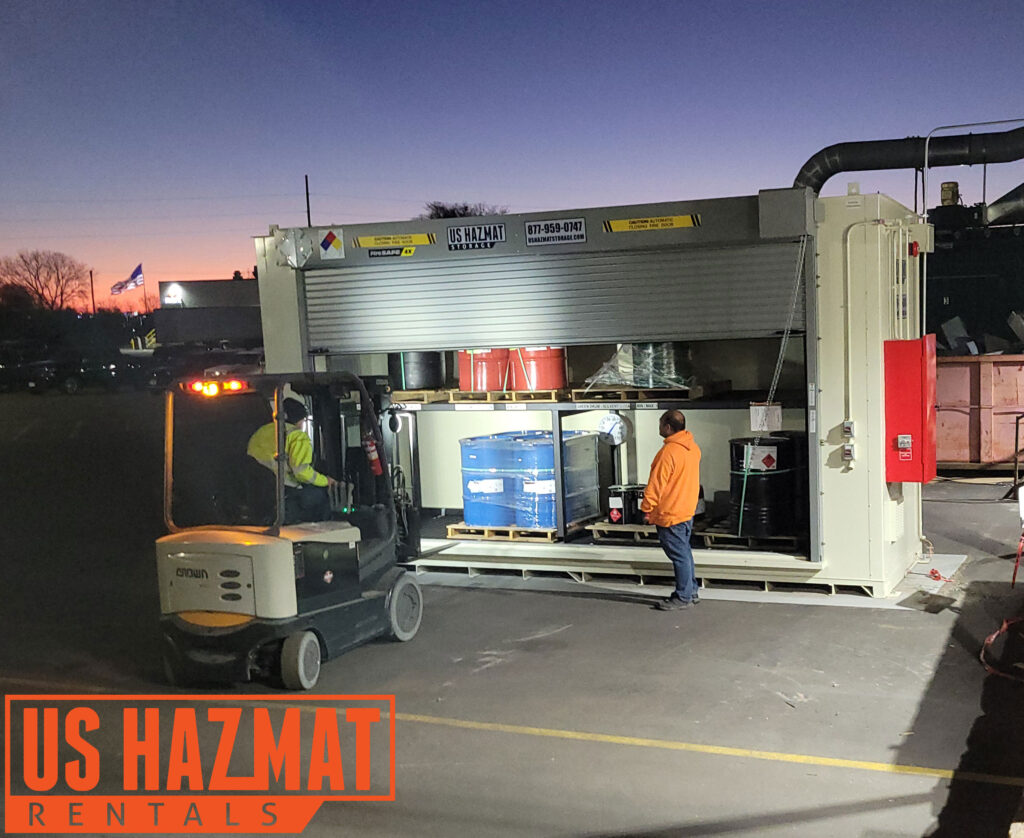Although April is Hazardous Materials Safety Month, manufacturers should always prioritize compliant chemical storage. FEMA is underscoring onsite chemical safety and hazard mitigation with a preemptive public awareness campaign. Noncompliant chemical storage practices cause irreparable harm and employee injuries. While most hazmat incidents are preventable, congruent, and systemically compliant, chemical warehousing engenders staff confidence while minimizing overhead with streamlined, sensible chemical storage. US Hazmat’s comprehensive and versatile chemical storage lockers and warehouses complement all-sized inventories and dangerous chemicals classifications. Our astute building advisors provide keen insight into all industries housing dangerous chemicals, allowing premises custodianship and best regulatory practices for maintaining hazardous materials without curtailing workflow operations.
“We should all be familiar with the chemicals that are used near us by more than 9,000 active facilities,” IEMA-OHS Interim Director Khayyat said. “These chemicals could be used every day as detergents, fuels, medicines, and more and IEMA-OHS is prepared for any incident that involves these chemicals.”
What are the Four Types of Hazardous Materials?
The EPA divides all hazardous materials into four categories based on reactivity, flammability, and harm propensity. The four categories are ignitability, corrosivity, reactivity, and toxicity. Although the four types of hazardous materials are broad and inclusive, recognizing prevalent onsite hazards, regardless of origin, emphasizes onsite safety by cordoning off dangerous chemicals with fire-rated steel protection with optional enhanced safety measures. All hazardous material stockpiles are dangerous and harmful if stored in critical mass in inhospitable working environments, including extreme temperatures, near incompatible materials, breached or compromised containers, or in unmanageable corridors teeming with fall and trip hazards. Moreover, noncompliant chemical storage hinders chemical consistency, composition, applicability, and timely procurement for dwindling supplies.
What are the Guidelines for Storage of Hazardous Materials?
Unpredictable hazmat incidents don’t take a holiday. Hazardous Materials Safety Month is a salient reminder that warmer weather, coinciding with an uptick in manufacturing orders and construction, can lull safety managers into a prevailing false sense of complacency ripe for accidental chemical discharges. Chemical spills, leaks, and fires occur almost daily. Site managers and operators can minimize hazmat incidents with compliant, streamlined chemical storage that allows sensible stacking, drum palletizing, and product inventorying. All employees must store hazardous materials below eye-level, affording companies ample views of storing conflicts arising from egress impediments and incompatibilities while monitoring containers’ structural integrity. Our NFPA 30 compliant chemical storage warehouses enthrall worksites with practical and sturdy temporary dangerous chemical storage without eating away at the bottom line. Wide-swinging or customizable roll-up doors allow for the easy removal and retrieval of dangerous chemicals between application and product manufacturing stages.

- Follow the instructions on the label for use and storage
- Don’t mix products
- Store products in their original containers
- Store anything that can catch fire away from your home
- Only fill portable gasoline containers outdoors, and place them on the ground before filling
- Never store materials that can cause a fire in the sun or near an open flame or heat source
- Keep hazardous materials out of the reach of children and pets
- Use safety locks and guardrails on shelves and cabinets where you store materials so they don’t fall or tip
- Wear gloves and goggles when you use the materials
What are the OSHA Requirements for Hazmat Storage?
Companies storing more than 25 gallons of flammable materials must keep those stockpiles in a designated chemical storage area or warehouse. OSHA safety standards also require all employers to keep storage areas free of hazards, debris, clutter, and other materials that could lead to fire. Furthermore, OSHA recommends placing all hazardous materials at least 10 feet from exterior walls. Our chemical storage lockers and warehouse rentals safely accommodate stockpiles and workloads for warehouses, construction zones, remote operations, paint storage, and other seasonal operations. We fabricate each OSHA compliant flammable storage warehouse to your site’s specification without superfluous upcharges.






